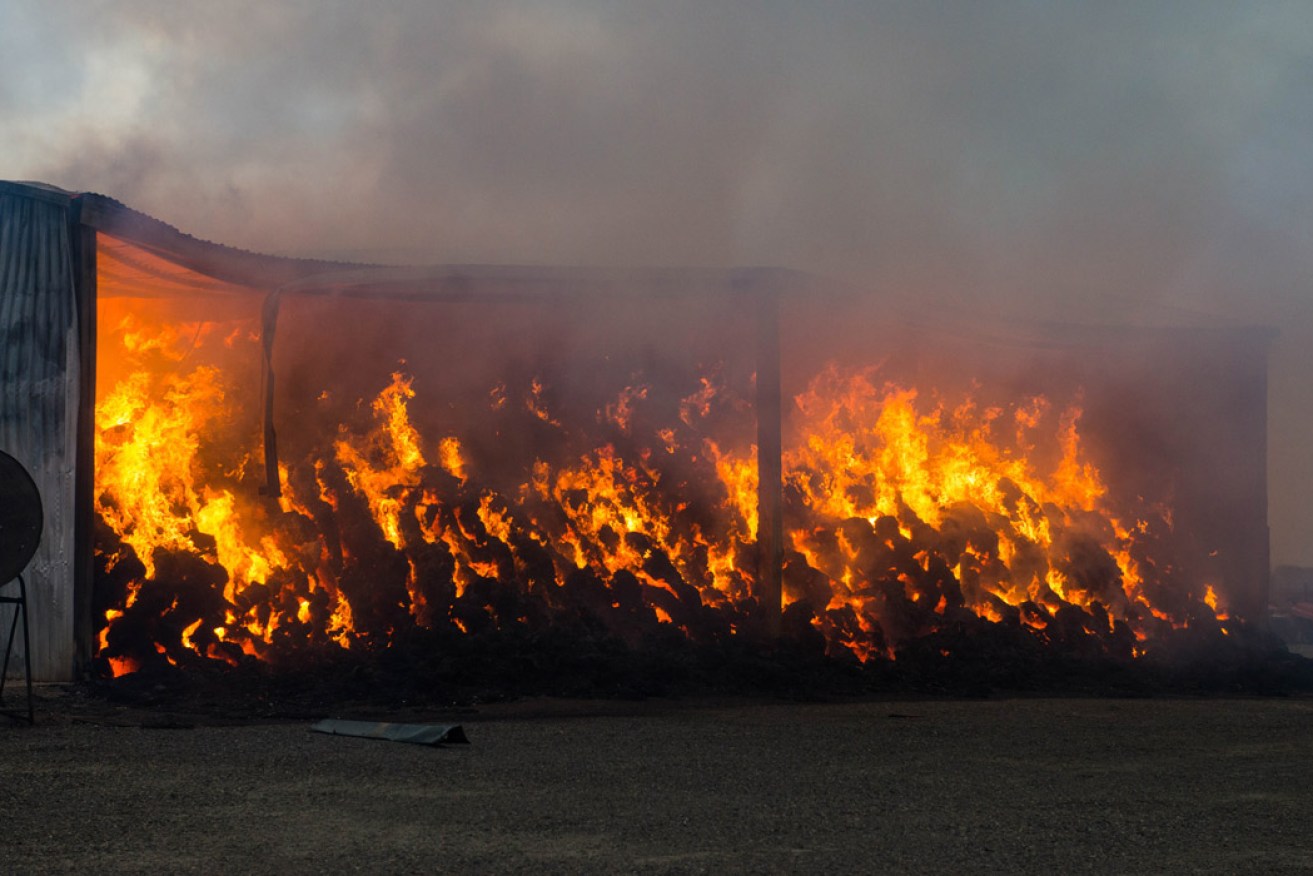The bushfire dragon arrives early in South Australia
The dragon came early this year. Fuelled by catastrophic fire conditions, it swept across 82,000 hectares of prime farm land north of Adelaide last week in a reminder to all Australians just how ferocious nature can be.

A hay shed burns on a property near Freeling during the recent Pinery bushfire. Photo: AAP / Brenton Edwards.
South Australia’s first major bushfire of the season claimed two lives and destroyed close to 500 buildings as it burnt fiercely for the best part of three days.
It was back in 1965 that celebrated children’s author Colin Thiele first used the mythical creature to give life, so to speak, to the dreaded summer phenomenon in his novel February Dragon.
In the dramatic climax to what has since become a classic Australian story, Thiele told how the land “boiled over with flame” as a fire raged.
“Huge masses of flame like outbursts from the sun’s rim broke away from the fire and shot high into the air, flapping and folding in fierce incandescent sheets,” he wrote.
“Whole trees exploded into torches. There was fire on the ground and fire like hellish harpies in the air.
“The whole world was writhing and flinging, convulsing, twisting … and dying.”
In Thiele’s tale and time, the risk of major fires was considered to be highest in the latter months of the season, especially February.
Some of South Australia’s worst bushfire disasters from past decades tell a similar story.
The 1983 Ash Wednesday catastrophe, when 28 people were killed, struck in February as did the fires in 1980 that destroyed 51 homes in the Adelaide Hills.
But now fire authorities, forecasters and even the state’s premier say times have changed and South Australians must be prepared for serious fires much earlier.
Touring the fire ground last week had served as a stark reminder of the destructive forces of nature, Premier Jay Weatherill said.
“I hope that this is the only bushfire site I will survey this summer but I fear there will be worse to come,” he said.
More recent history gives strength to the premier’s concerns.
In 2005, nine people were killed and 79 houses destroyed in a fire that burnt across SA’s Eyre Peninsula in January and in 2007 a major fire in December destroyed 95,000 hectares of scrub on Kangaroo Island.
While in the first few days of 2015 a fire burnt through more than 13,000 hectares of forest and scrub in the Adelaide Hills, destroying 27 homes and injuring 134 people.
So it should have come as no surprise when the Country Fire Service brought forward the fire danger season in some districts this summer, concerned by the prevailing dry conditions and high fuel loads.
Chief officer Greg Nettleton said last week’s inferno was a demonstration of what could now easily happen in November, and happen again in the coming months.
The state was incredibly dry and only long, soaking rain would cut the fire risk, he said.
“Until we get really substantial rainfall across the state, we’re in a dangerous fire situation for the summer.
“We’ve still got December, January, February and March to get through.”
Last month the Bushfire and Natural Hazards Cooperative Research Centre also warned of increased fire risk across southern Australia, and South Australia in particular.
It said some areas might not have sufficient fire fighting resources.
Low rainfall had contributed to a rapid and early drying of vegetation while many areas had also experienced record high temperatures.
“In these areas, it is more likely that the resources required to fight bushfires from within a region will be insufficient, with resources required from other areas of an affected state, interstate and possibly overseas,” the centre said.
Resources in SA were indeed stretched last week, with more than 300 firefighters brought in from Victoria to relieve local crews.
All the state’s water bombing aircraft were deployed along with two aircraft from NSW.
Ultimately the blaze was contained within 48 hours, an incredible achievement considering how quickly it spread.
Veteran firefighters were staggered by its speed. At one stage it travelled 50kms in just four hours, devouring crops, grass and scrub, and defying efforts to place significant resources in advance of the 40km-wide front.
When such fires are tamed, Thiele likened it to the dragon “driven back to his cage”.
“But he was not destroyed,” Thiele wrote.
“He was just waiting for another chance. He is waiting now.”
AAP




